

| By the mid-18th century Brighton had become a fashionable resort, largely because of the supposed benefits of its sea water. George, the Prince of Wales (and later Prince Regent) as well as his uncle, the Duke of Cumberland, frequented Brighton. The Prince first visited at his uncle's house and later stayed in the first version of the "Pavilion" which in the late 18th century was a simple neo-classical building designed by Henry Holland. From 1811-20 George was the Prince Regent and is was primarily during this time period that John Nash transformed the earlier structure. Prior to the time of the Regency, Nash had designed country houses, some classical, but most "Gothic"--all illustrating Picturesque ideals. Here he uses the Indian style, influenced both by Humphrey Repton's designs for a Pavilion for the Prince as well as Thomas Daniell's 4-volume Oriental Scenery. After George IV's death, Queen Victoria used the Pavilion but eventually sold it to Brighton in 1850. | ||
View of the west side looking toward the long porch for the King's Apartments to the northVisitors would have exited their coaches under this porte cochère--a domed entrance porch |
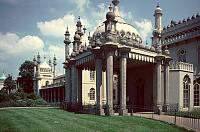
|
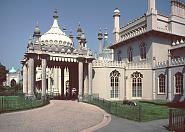
|
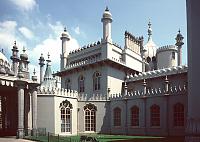
|

|
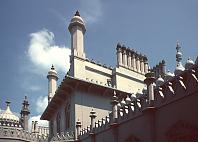
|
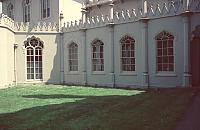
|

|
Details include exuberant stonework, sometimes supported internally by iron cores (for example, the minarets), bulbous oriental domes and unusual crenelation, and exotic decoration. |
The porte cochère--a domed entrance porch | ||
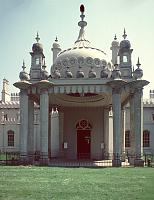
|
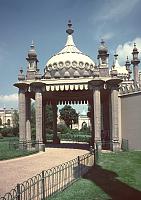
|
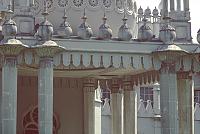
|
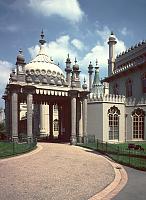
|

|
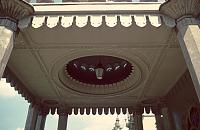
|

|
While the exterior is described as "Indian," the lavish interior is more Chinese with gilded dragons, imitation bamboo staircases, and bold color. The Great Kitchen has cast iron palm tree columns and the Banqueting Room a spectacular chandelier held by a silver gilt dragon. For excellent photographs of the interior, see this site. | |
 Click here to return to index of art historical sites.
Click here to return to index of art historical sites.
 Click here to return to index of artists and architects.
Click here to return to index of artists and architects.
 Click here to return to chronological index.
Click here to return to chronological index.
 Click here to see the home page of Bluffton College.
Click here to see the home page of Bluffton College.
